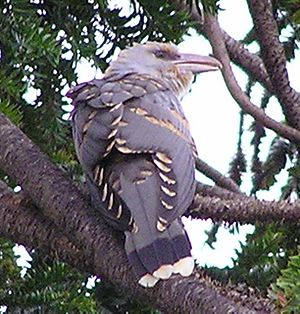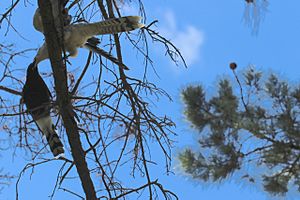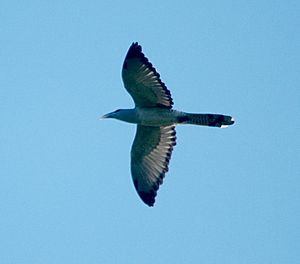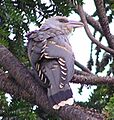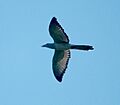Channel-billed cuckoo facts for kids
Quick facts for kids Channel-billed cuckoo |
|
|---|---|
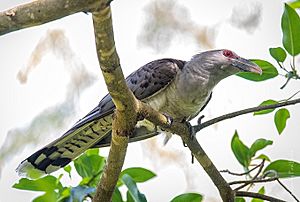 |
|
| adult | |
| Conservation status | |
| Scientific classification | |
| Genus: |
Scythrops
|
| Species: |
novaehollandiae
|
| Synonyms | |
|
Scythrops psittaceus Kerr, R. 1792 |
|
The channel-billed cuckoo (Scythrops novaehollandiae) is a very large bird from the cuckoo family. It is the biggest cuckoo in the world! This amazing bird is known for being a "brood parasite," which means it lays its eggs in the nests of other birds instead of raising its own chicks.
You can find channel-billed cuckoos in Australia, New Guinea, and Indonesia. Sometimes, they even visit places like New Caledonia and New Zealand. These birds often travel long distances, migrating across parts of their range. Scientists have identified three different types (subspecies) of this cuckoo. Some stay in one place, while others migrate. The good news is that the channel-billed cuckoo is not considered endangered; its population is stable.
Contents
What is the Channel-billed Cuckoo's Name Story?
The channel-billed cuckoo got its scientific name, Scythrops novaehollandiae, in 1790 from a scientist named John Latham. He worked with Captain Arthur Phillip, who first described this unique bird. They thought it looked a bit like a parrot, a hornbill, or even a toucan!
The name Scythrops comes from ancient Greek words meaning "angry" or "sullen" and "face" or "eye." So, it means "sullen-faced." The second part, novaehollandiae, simply means "from New Holland," which was an old name for Australia.
There are three main types (subspecies) of the channel-billed cuckoo:
- Scythrops novaehollandiae novaehollandiae: Found in Australia, New Guinea, and the Moluccas.
- Scythrops novaehollandiae fordi: Lives in Sulawesi.
- Scythrops novaehollandiae schoddei: Found in the Bismarck Archipelago.
This cuckoo is the only bird in its group, called Scythrops. Its closest relative is the Pacific long-tailed cuckoo, which breeds in New Zealand. The official common name for this bird is "channel-billed cuckoo." Latham gave it this name because of a special groove on its upper beak.
What Does the Channel-billed Cuckoo Look Like?
The channel-billed cuckoo is the largest cuckoo in the world. It can be about 56–70 cm (22–28 in) long, which is roughly the length of your arm! Its wingspan can reach 88–107 cm (35–42 in), and it weighs between 560–935 g (1.235–2.061 lb). That's about as heavy as a small bag of sugar.
Its bill is very noticeable. It's large, slightly curved, and looks a bit like a hornbill's beak. It's grey at the bottom and turns straw-coloured at the tip. The adult bird's feathers are pale grey on its head, chest, belly, and back. Its wings are a darker grey with dark tips. The tail is dark grey on top and has black and white stripes underneath. Its legs and feet are black, and it has bright red skin around its eyes.
Even though it's a big bird, the channel-billed cuckoo spends a lot of time in trees. It's also a very strong flier. When it flies, it has a special cross-shaped outline, almost like a hawk. Male and female cuckoos look a little different. Females usually have a smaller beak and lighter, more striped feathers on their undersides.
Young channel-billed cuckoos (juveniles) look similar to adults. However, their wing feathers have pale tips, and their other feathers are a light brown color instead of grey. Their beaks are smaller and pinkish, and they don't have the red skin around their eyes yet.
Where Do Channel-billed Cuckoos Live?
Channel-billed cuckoos are found across northern and eastern Australia, New Guinea, the Bismarck Archipelago, and islands in eastern Indonesia like Sulawesi. Some of these birds live in one place all year round, especially in the Bismarck Archipelago, Flores, and Sulawesi.
However, many channel-billed cuckoos are migratory. This means they travel between different places depending on the season. Birds that breed in Australia can be found from Western Australia all the way down to eastern New South Wales, including Sydney. In recent years, they have been seen even further south in New South Wales. Sometimes, a few birds even reach Victoria.
After the breeding season, usually in March and April, the cuckoos that bred in Australia fly north. They head to New Guinea and Indonesia for the winter. They cross the Torres Strait either alone or in small groups. They continue their journey to islands like Timor and the Moluccas. In August and September, these migrating cuckoos start to return to Australia.
How Do Channel-billed Cuckoos Behave?
The channel-billed cuckoo can be quite shy. It often stays hidden high up in tree canopies, especially when it's looking for food in the early morning or evening. You might hear its loud, harsh call more often than you see the bird itself! Other birds, like crows, sometimes chase and bother the cuckoo when they spot it.
How Do Channel-billed Cuckoos Raise Their Young?
Channel-billed cuckoos are famous for being brood parasites. This means they don't build their own nests or raise their own young. Instead, the female cuckoo lays her eggs in the nests of other bird species.
It's thought that male and female cuckoos stay together for one breeding season. Their mating involves the male giving the female food, like insects. They also work together to lay eggs in other birds' nests. The male might fly over a nest to make the parent birds angry and chase him. While they are busy, the female quickly slips into the nest to lay her egg. Another way they do it is by attacking a bird sitting on its eggs, driving it away so the female can lay her egg.
The types of birds they trick into raising their young can vary. Common "host" birds include ravens, currawongs, butcherbirds, and Australian magpies. Sometimes, several cuckoo eggs, even from different female cuckoos, can be found in one nest. The cuckoo eggs often look similar to the eggs of currawongs and magpies, but not ravens. They can be reddish-brown, yellowish-brown, or dull white, with darker brown spots.
When the cuckoo chicks hatch, they are blind and have no feathers. Unlike some other cuckoos, these chicks don't push the other eggs or chicks out of the nest. However, the cuckoo chick grows very fast and demands all the food. This often means the host's own chicks don't get enough to eat and don't survive. Within about four weeks, the cuckoo chicks have all their feathers and leave the nest. They still rely on their "foster" parents to feed them for several more weeks after they leave the nest.
What Do Channel-billed Cuckoos Eat?
Most cuckoos eat insects, but channel-billed cuckoos are different. They eat a lot of fruit, just like their relatives, the koels. They enjoy fruits from many types of fig trees, such as Moreton Bay figs and Port Jackson figs. They also eat fruits from mistletoe plants and even the black mulberry, which is a plant brought from other countries.
Besides fruit, they also eat insects like beetles, butterflies, and grasshoppers. Sometimes, they even eat the eggs and young chicks of other birds, including apostlebirds and magpie-larks. These cuckoos usually find their food high up in the tops of large trees. They might feed in groups or sometimes join other fruit-eating birds like Australasian figbirds.
How Do Humans Relate to Channel-billed Cuckoos?
In northern Australia, the arrival of channel-billed cuckoos often happens at the start of the rainy season. Because of this, people sometimes call them "storm-birds," "flood-birds," or "rain-birds." Since they eat fruit and look a bit like birds of prey, they are also sometimes called "fig hawks."
The channel-billed cuckoo is not considered an endangered bird. In fact, human activities have actually helped them! In some areas, their numbers have grown because people have planted more gardens around Australian cities. These gardens provide more homes for the birds that the cuckoos use as hosts for their eggs.
Images for kids
See also
 In Spanish: Cuco tucán para niños
In Spanish: Cuco tucán para niños



